Blue Orange Games, known for Spot It, has a couple new games that combine dexterity and quick thinking: Top That! and Dr. Eureka.
At a glance: Top That! is for 2 to 4 players, ages 6 and up, and takes about 15 minutes to play. Dr. Eureka is for 2 to 4 players, ages 8 and up, and takes about 15 minutes to play. Both retail for $19.99 and are available in stores and online. The age ratings seem about right; younger players could certainly play with the components, but the puzzle-solving and dexterity aspects may be a little more challenging. (And, of course, don’t give them to kids who will choke on small items.)
Both games have some similarities, but I’ll explain the components and how to play separately.
Top That!

Components:
- 55 Challenge cards
- 4 sets of player pieces:
- Black Top Hat
- Red Cup
- Orange Tube
- Green Coin
- White Rabbit

The player pieces are plastic, and they can be stacked or nested. The rabbit fits inside the orange tube, which fits in the red cup, which fits in the black hat. The green coin also fits inside the hat, but otherwise can’t be nested. The pieces are pretty cute.
The challenge cards are square cards, with illustrations of various pieces on each card. The square cards can be a little awkward to shuffle, but are otherwise fine. The whole thing comes in a large square box with a window on the front to display one set of the player pieces—there’s a good bit of air in it, so you could easily fit the game in a smaller package for portability.
How to Play
The goal of the game is to score the most points—you can easily pick a set score to reach to end the game, or play for a particular amount of time or until the deck of cards runs out.
To set up, give each player a set of objects, and then shuffle the challenge cards and set them in the center of the table.
When everyone is ready, flip over the top card of the deck, and the challenge begins—everyone plays simultaneously. The card has a number of the pieces illustrated on it. Your goal is to be the first to stack those pieces following three rules:
- Objects in color on the card must be visible in your stack.
- Objects in grey on the card must be hidden somewhere inside your stack.
- Objects not on the card must be set aside and not included in the stack.
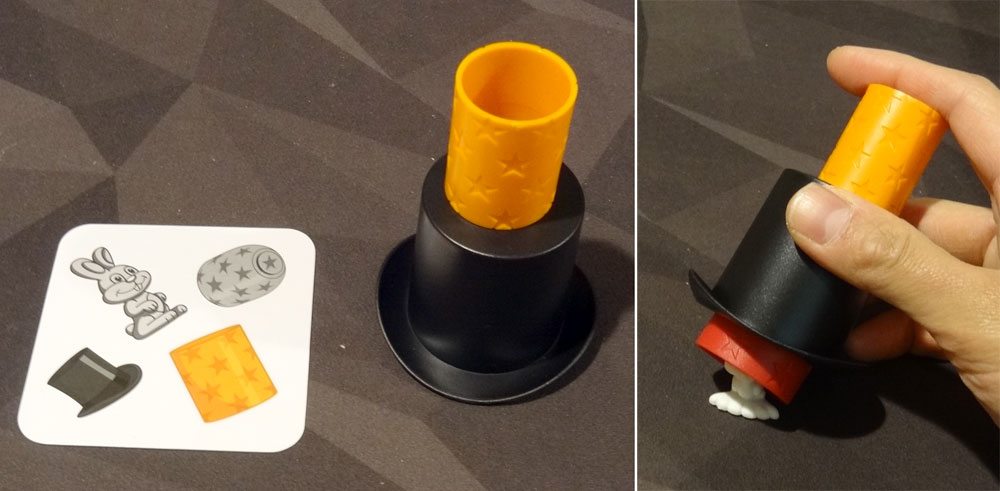
The first player to finish shouts “Top That!” and everyone checks to see if it was done correctly. If so, the player takes the card as a point. If not, the other players continue until somebody completes the challenge correctly.
Some cards also have one item surrounded by yellow stars—these are used for advanced play. You choose one of the following rules to use for advanced play:
- The object with yellow stars must be empty.
- The object with yellow stars must have something hidden inside.
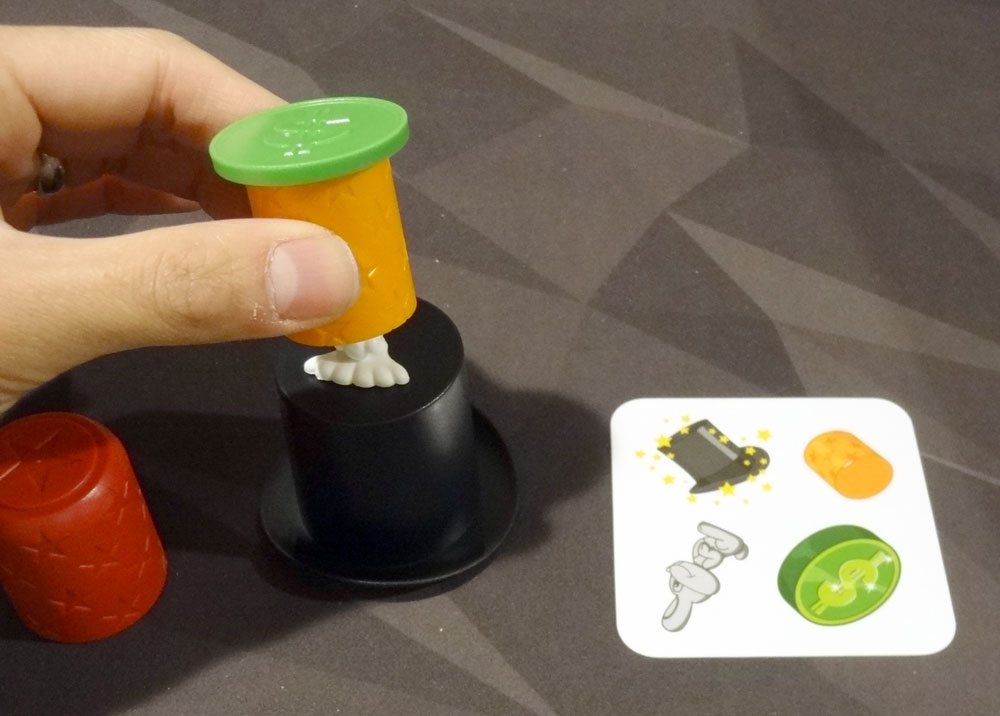
The game ends when somebody reaches a set number of points, or when you run out of cards, or some other agreed-upon ending.
Dr. Eureka
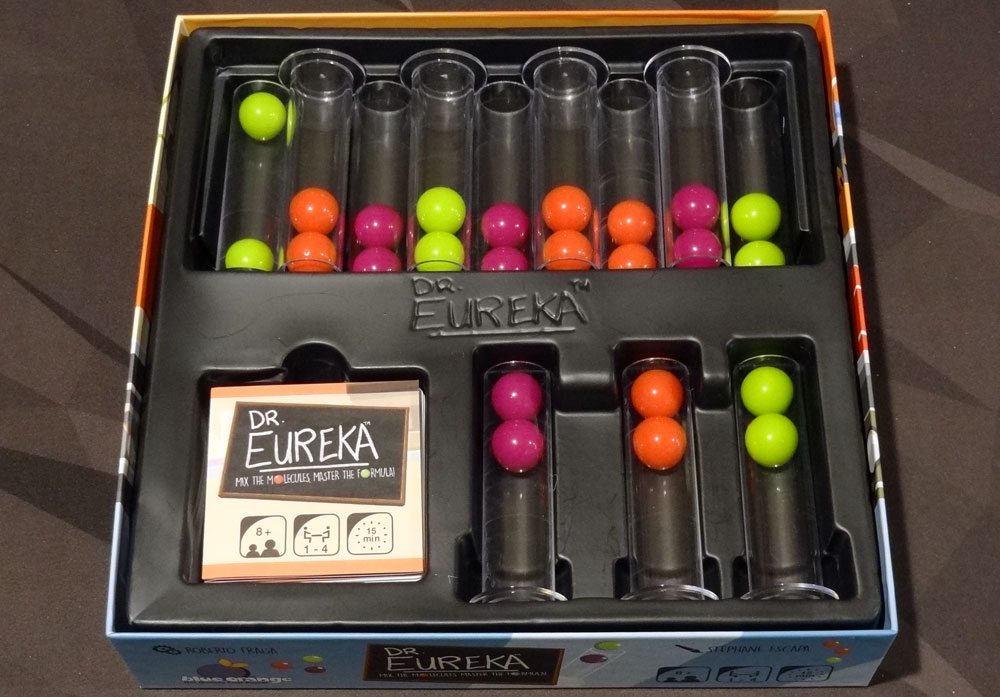
Components
- 54 Challenge cards
- 4 sets of player pieces:
- 3 Test tubes
- 2 Green Balls
- 2 Purple Balls
- 2 Red Balls
Like Top That!, the components here are a set of square cards and then a lot of plastic pieces. In this case, each player gets 3 test tubes and 6 plastic balls. The test tubes are clear plastic cylinders with a wider base so they stand up easily, and each is deep enough to hold 5 of the balls. The one concern I have is that the colors chosen are not the most color-blind friendly, nor even low-light friendly for those who are not color blind. Depending on your lighting, you may have trouble telling the red and purple apart.
The cards are square, which can be awkward to shuffle, but are otherwise fine. The box is the same size as Top That!, but the test tubes do take up more space (because they don’t nest the way the Top That! components do) so there isn’t quite as much wasted space, but there’s still a good amount of air in it.
How to Play
The goal of the game is to be the first to 5 points by completing challenges.
To set up, give each player a set of objects, and then shuffle the challenge cards and set them in the center of the table. Each player should start with two balls of the same color in each test tube.
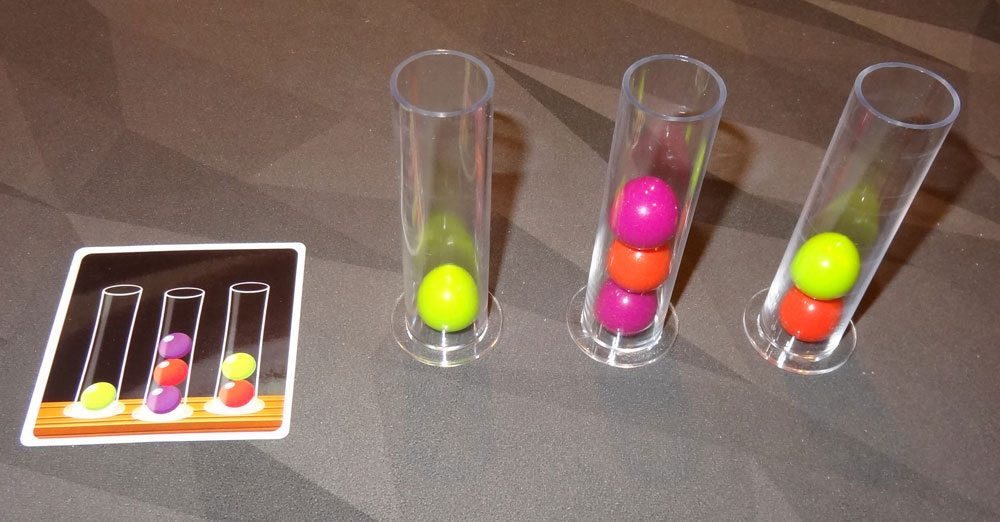
When everyone is ready, flip over the top card of the deck, and the challenge begins. Each card shows three test tubes, with the six balls in some configuration. Everyone tries to recreate that configuration simultaneously by pouring the balls from one test tube to another without touching the balls with their hands or spilling them. You may, however, flip a test tube upside-down on the table.
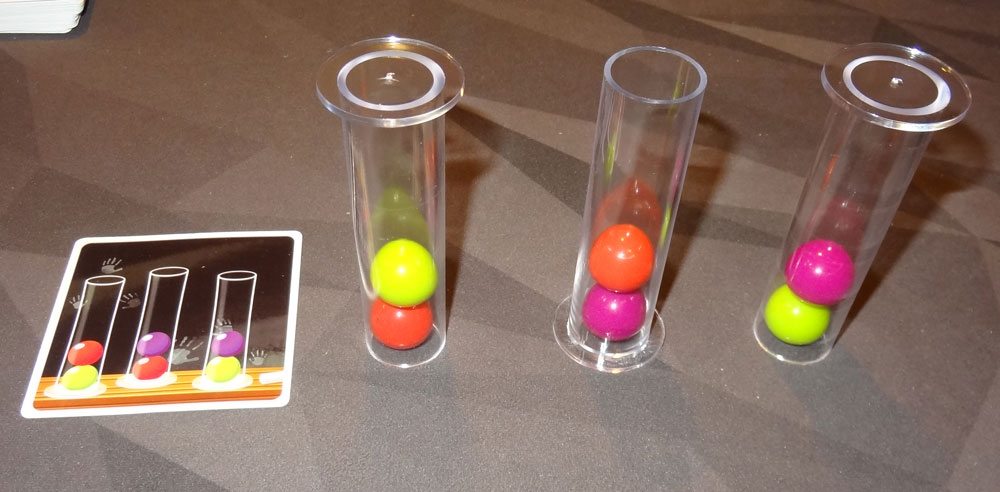
When you’re finished, you shout “Eureka!” and everyone stops to check your solution. The balls must be in the proper configurations from top to bottom, left to right, matching the card. If so, then you take the card and score a point. All test tubes are turned back right side up, but the balls are left in whatever configuration they were at the end of the last challenge.
The game ends when any player has reached 5 points.
There are two variations included in the rules:
Expert Mode: You must hold all 3 test tubes in your hands and cannot set them down until you’re ready to call “Eureka!”
Puzzle Mode: When the challenge card is revealed, instead of working on it simultaneously, players race to bid on the lowest number of moves they will take to complete it. Whoever bids the lowest gets a chance to complete the challenge for the point; if they fail, the next highest bidder gets a chance, and so on.

The Verdict
Top That! and Dr. Eureka scratch a particular gaming itch for speedy puzzles. Like Set and Ghost Blitz, they challenge you to figure out a puzzle at the same time as everyone else. In this case, there’s also the added twist of dexterity: stacking items in Top That! and pouring marbles back and forth in Dr. Eureka. It’s not enough just to solve the puzzle: you also have to complete the physical challenge, and you have to be the quickest.

While the two are very similar, Top That! is more appropriate for younger kids because the stacking is a little easier to figure out. The pieces are really cute toys, and the puzzle-solving side of it will not present as much of a challenge to older players (other than competing on speed). The trick in Top That! is that it’s easy to forget to hide the pieces that are grey-colored on the card, particularly the rabbit, since it will be either white or grey. If playing with older players, I highly recommend using one of the advanced rules to add one more restriction. And if you’ve got adults playing with younger kids, you can handicap the game easily by having the adults play by advanced rules while the kids play with basic rules.
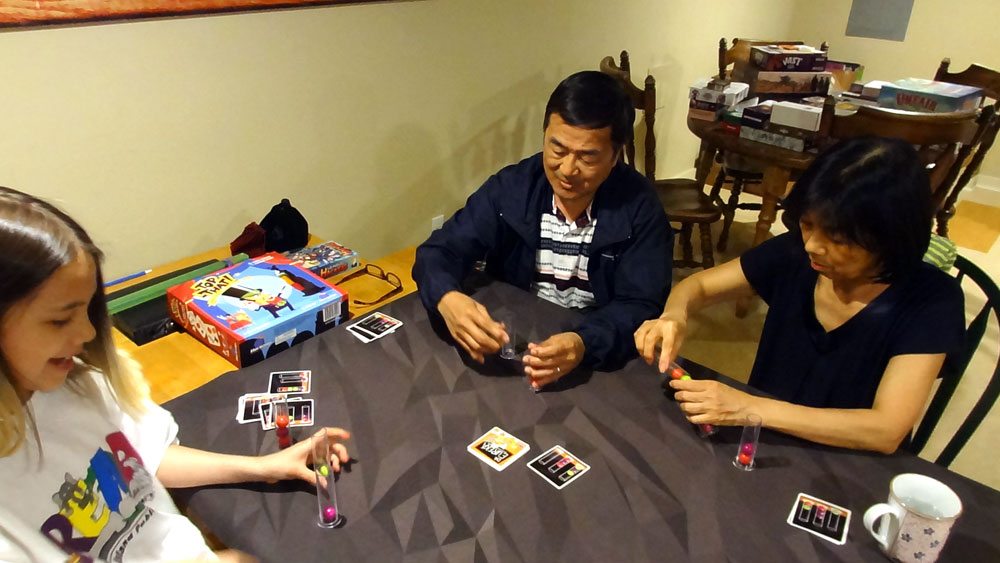
The puzzle-solving in Dr. Eureka is a step up: it’s a little bit like Towers of Hanabi, because you have to shuffle the marbles among the three test tubes to get them all in the right order. I like that it’s a combination of logic and dexterity: if you’re fast at figuring out the fewest number of steps, then you don’t have to be as quick or dexterous in pouring the balls back and forth. Or, you could just be really skillful at pouring and take a less-efficient path to solving the puzzle. Either way, it’s a game that can present a nice challenge for both kids and adults. And even though the rules say to stop when somebody gets to 5 points, we’ve found that we often just continue playing much longer, just because it’s so fun.
Overall, I think this is an excellent pair of games for a family collection. If you’ve got younger kids, Top That! is easier to manage, but for older kids and adults I highly recommend Dr. Eureka. (Just watch where you play because if somebody spills, those marbles will roll everywhere.)
Disclosure: I received review copies of these two games.




